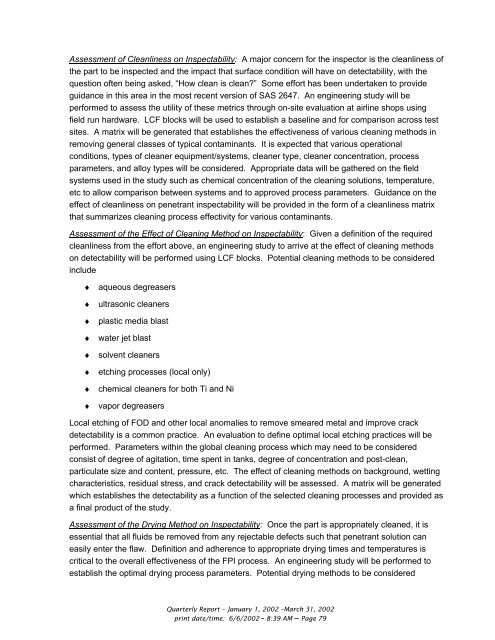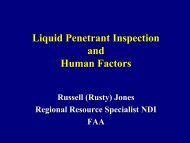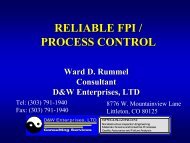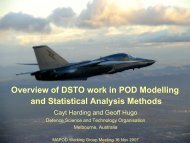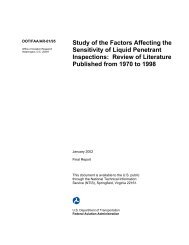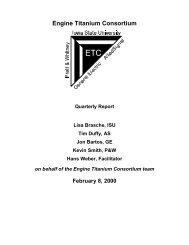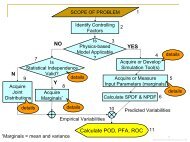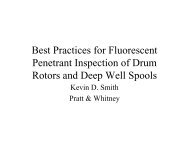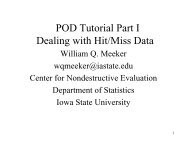Engine Titanium Consortium - Center for Nondestructive Evaluation ...
Engine Titanium Consortium - Center for Nondestructive Evaluation ...
Engine Titanium Consortium - Center for Nondestructive Evaluation ...
You also want an ePaper? Increase the reach of your titles
YUMPU automatically turns print PDFs into web optimized ePapers that Google loves.
Assessment of Cleanliness on Inspectability: A major concern <strong>for</strong> the inspector is the cleanliness of<br />
the part to be inspected and the impact that surface condition will have on detectability, with the<br />
question often being asked, “How clean is clean?” Some ef<strong>for</strong>t has been undertaken to provide<br />
guidance in this area in the most recent version of SAS 2647. An engineering study will be<br />
per<strong>for</strong>med to assess the utility of these metrics through on-site evaluation at airline shops using<br />
field run hardware. LCF blocks will be used to establish a baseline and <strong>for</strong> comparison across test<br />
sites. A matrix will be generated that establishes the effectiveness of various cleaning methods in<br />
removing general classes of typical contaminants. It is expected that various operational<br />
conditions, types of cleaner equipment/systems, cleaner type, cleaner concentration, process<br />
parameters, and alloy types will be considered. Appropriate data will be gathered on the field<br />
systems used in the study such as chemical concentration of the cleaning solutions, temperature,<br />
etc to allow comparison between systems and to approved process parameters. Guidance on the<br />
effect of cleanliness on penetrant inspectability will be provided in the <strong>for</strong>m of a cleanliness matrix<br />
that summarizes cleaning process effectivity <strong>for</strong> various contaminants.<br />
Assessment of the Effect of Cleaning Method on Inspectability: Given a definition of the required<br />
cleanliness from the ef<strong>for</strong>t above, an engineering study to arrive at the effect of cleaning methods<br />
on detectability will be per<strong>for</strong>med using LCF blocks. Potential cleaning methods to be considered<br />
include<br />
♦ aqueous degreasers<br />
♦ ultrasonic cleaners<br />
♦ plastic media blast<br />
♦ water jet blast<br />
♦ solvent cleaners<br />
♦ etching processes (local only)<br />
♦ chemical cleaners <strong>for</strong> both Ti and Ni<br />
♦ vapor degreasers<br />
Local etching of FOD and other local anomalies to remove smeared metal and improve crack<br />
detectability is a common practice. An evaluation to define optimal local etching practices will be<br />
per<strong>for</strong>med. Parameters within the global cleaning process which may need to be considered<br />
consist of degree of agitation, time spent in tanks, degree of concentration and post-clean,<br />
particulate size and content, pressure, etc. The effect of cleaning methods on background, wetting<br />
characteristics, residual stress, and crack detectability will be assessed. A matrix will be generated<br />
which establishes the detectability as a function of the selected cleaning processes and provided as<br />
a final product of the study.<br />
Assessment of the Drying Method on Inspectability: Once the part is appropriately cleaned, it is<br />
essential that all fluids be removed from any rejectable defects such that penetrant solution can<br />
easily enter the flaw. Definition and adherence to appropriate drying times and temperatures is<br />
critical to the overall effectiveness of the FPI process. An engineering study will be per<strong>for</strong>med to<br />
establish the optimal drying process parameters. Potential drying methods to be considered<br />
Quarterly Report – January 1, 2002 –March 31, 2002<br />
print date/time: 6/6/2002 - 8:39 AM – Page 79


